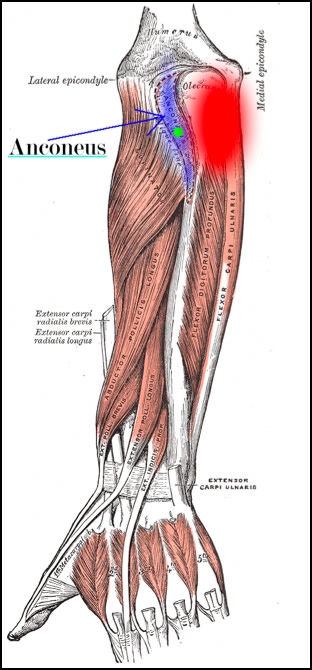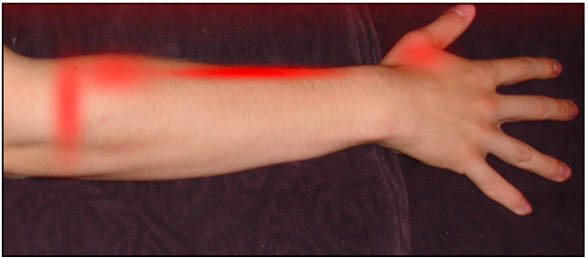How To Treat Tennis Elbow - Part 1
How do I know how to treat tennis elbow? I had it, and it was royally painful and ten-thousand kinds of infuriating.
Weight training is one of the best methods of strength training! If you want to start weight training safely and effectively, with the best info, diet, and routines, check out the 5 Day Beginner Weight Training Course!
And now I do not have tennis elbow.
In the winter of 2007 I could barely hold a cup of tea without pain, and I was angry. It seemed like there were so many different chunks and pieces of info about how to treat tennis elbow, but I only had a few of them.
However, through meeting unhelpful doctors and physical therapists and reading everything I could lay my hands on I was able to cure myself. I've got no elbow pain, even today with weight training and swordsmanship and martial arts and dancing.
I've compiled the most important information that I found about how to treat tennis elbow right here. Read the info below, try it, and I really hope it helps you as much as it helped me.
Since this article is so long, I've broken it into How to Treat Tennis Elbow - Part 1 (this page) and Treatments for Tennis Elbow - Part 2.
How To Treat Tennis Elbow - Part 1
Table of Contents:
- R.I.C.E. (Rest, Ice, Compression, Elevation)
- N.S.A.I.D.s
- Stretching
- Trigger Point Index
- Cortisone Injection
- Surgery
- Conclusion
◆ R.I.C.E. For Tennis Elbow
R.I.C.E. (rest, ice, compress, elevate) is the standard method of treating any sports injury. And while it's great for acute injuries, it's not so great for repetitive motion injuries (RMIs) like tennis elbow.
Resting and icing are good measures. The rest will help you recover from whatever damage you're doing (or at least not make it worse), and the ice will help reduce inflammation.
The compression and elevation are not as helpful. The elevation is supposed to make it harder for blood to be pumped into the injured body part, and the compression should further slow the blood flow.
These are great for a wound or acute injury that you don't want bleeding or becoming inflamed!
But that's not what you're fighting with an overuse injury.
There's no extreme inflammation from a single incident, so elevation and compression won't noticeably help restrict the blood flow - the blood flow is already 'normally' in its inflamed state. Also, a chronic use injury has had numerous stresses over the time building up to it, so the recovery time is longer than a day or two.
It just isn't practical (or even helpful) to keep your elbow elevated and compressed for days.
So...
Use resting and icing as a first line of defense for how to treat tennis elbow. They should help and you will be able to do them without much difficulty for a few days. See how much of a difference they make.
If icing has no effect or causes you pain, you might have trigger points and tight muscles (see below). If your pain is really related to tight muscles, then check out the stretching and trigger point sections.
◆ N.S.A.I.D.s
Non-steroidal anti-inflammatory drugs (N.S.A.I.D.s for short) can be extremely helpful for relieving pain & inflammation. Ibuprofen and Aspirin are the most common of these and are cheap, effective, and you probably have them in your own home. Score!
N.S.A.I.D.s will work to bring down your inflammation and the pain associated with it. For therapeutic purposes you will have a higher dosage than normal, though for an appropriate dosage please consult your doctor.
If the cause of your tennis elbow is genuinely inflammation of the Extensor Carpi Radialis Brevis (ECRB) tendon in the elbow, it can be helped by taking N.S.A.I.D.s. But if you've had tennis elbow for a long time (months or even years), this may not be very effective.
◆ Stretching
If you've already determined that the true cause of your tennis elbow symptoms is tendon inflammation, how to treat tennis elbow is NOT to stretch it. Stretching will cause you a lot of pain and do damage.
However, if your pain is related to tight muscle then stretching can really help.
Tight muscles, associated with trigger points and other unfriendly pains, can mimic the symptoms of tennis elbow. In this case, if icing and anti-inflammatory drugs have not helped you, try stretching your wrists & forearms.
If you have inflammation that is going down, start these stretches when they don't cause pain. They can help keep you from developing the inflammation and tightness again.
◆ The Trigger Point Index
Muscle trigger points are muscle knots, places in your muscle that stay contracted long after they should relax. If you've ever massaged someone's neck and they say, "OOOhh, that's it!" you know what I mean.
If your tennis elbow is caused by trigger points then it is not 'true' lateral epicondylitis (tennis elbow). It's a muscle condition that gives you the same symptoms tennis elbow does.
But happily, trigger points are much easier to treat than tennis elbow inflammation. :-)
Note: One method of easing trigger point pain is through heat (hot packs, showers, baths, etc.) that help the muscle relax. However, true tennis elbow inflammation will be made worse with heat, and ice is the best thing to bring it down.
The answer? Consult your doctor, or use the handy guide: if it hurts to heat it, use ice. If ice hurts, use heat.
This is a list of the muscles that refer pain to the back of your elbow, listed in alphabetical order. These are the same muscles that mimic pain commonly mistaken for tennis elbow.
There are just 10 of them, so go through each one and check to see if they cause good-massage-pain when you apply pressure to them. If they do cause you pain (more than just pushing on your muscle should), then you've found a trigger point.
Your mission for how to treat tennis elbow: seek out and massage out the trigger points.
The trigger points are marked with green dots and the referred pain patterns that they cause are highlighted in red. Though most of the trigger points presented here have their primary pain associated with parts of the forearm and hand, ALL of them can cause pain on the outside of the elbow.
Remember, your muscles should feel springy & not painful when healthy, sort of like freshly cooked pasta. If your muscle is harder than fresh pasta and hurts, massage it.
Try using your muscles immediately after the massage to see if there’s an improvement. When you start massaging trigger points, the pain should be noticeably lessened after just a few massages (1-2 minutes of working on the painful muscle).
If this helps you and/or you are interested in trigger points, I recommend that you buy a copy of Clair Davies’ The Trigger Point Therapy Workbook: Your Self-Treatment Guide for Pain Relief. This excellent work presents the science and information regarding trigger points in layman’s terms, with everything you need for how to cure tennis elbow & any other kind of trigger point pain through-out your entire body.

Anconeus[1]
The Anconeus muscle is located right behind the elbow. It works primarily to complement the tricep's extension of the elbow, and to support the elbow joint. It most often gets trigger points when there’s an impact to the elbow, or repetitive elbow motion.
As the diagram to the right shows, a trigger point in it sends pain to the back of the elbow. You can feel it contract when you rotate your hand to the side, to shake hands or turn a doorknob.
Brachioradialis[2]

It is easy to get this confused with the Anconeus muscle and the Supinator, but just work forward of the elbow on the inside of the forearm. And, when in doubt, if there's a muscle that's painful and hard, work on it.
You can see the trigger point shown in the diagram to the right with the hand palm up, and the referred pain pattern below.

To learn more about how the different trigger points that can cause tennis elbow & other methods of how to treat tennis elbow, simply click here to go to Treatments for Tennis Elbow - Part 2.
Oh, and be sure to sign up for the e-zine Starting Strong to get monthly strength training, exercise, and diet tips e-mailed to you - and access to the free e-book Train Smart, Eat Smart: Exercise Nutrition Hacks!
• Click here to learn more about delayed onset muscle soreness and Treating Muscle Aches & Pains!
OR
• Click here to leave 'How To Treat Tennis Elbow - Part 1' & go back to the Home-page!
How To Treat Tennis Elbow - Part 1
References:
1. Davies, Clair. 2004. The Trigger Point Therapy Workbook: Your Self-Treatment Guide For Pain Relief. Oakland, CA: New Harbinger Publications. Pp. 113.
2. Ibid. Pp. 110.
Search CST...
|
Tweet Follow @Aaron_CST |
|
"About 2 weeks ago I read all the ab strengthening stuff on your site because I decided I wanted to be strong, instead of having a lot of belly fat. So I started eating healthier, running, exercising, you name it - everything your site said to do to help. Now I am noticing a real difference! Thank you for making this. :D xD" ~ Julia |
|
[This calorie calculator is] the most useful tool on the web that I can find… Also, I compared the calories calculated by your calculator to the calories calculated by the treadmill at my gym, and they're within a couple calories of each other, so yours is as accurate as we're going to get. REALLY AWESOME TOOL. I love it and depend on it. Thank you sooooo much for making this available." ~ Galit Sharon Marcus |
|
Thank you very much, I was too lean before 2 years (55 Kgs), after the gym now I'm 72kgs, all the muscles have developed... when someone hand shakes with me it can be squeezed easily, they're making fun of me! ~ Tamil Arasan |






New! Comments
Have your say about what you just read! Leave me a comment in the box below.